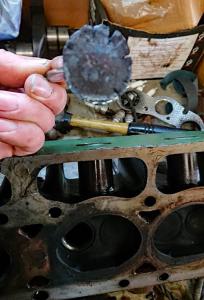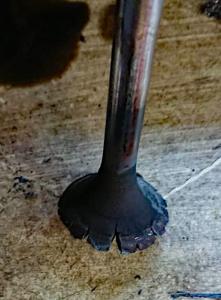Ethanol in Petrol, engine coolant and tyre pressures
Traction Owner’s Club › Forums › Technical › Engine › Ethanol in Petrol, engine coolant and tyre pressures
- This topic has 28 replies, 9 voices, and was last updated 4 years, 2 months ago by Dave Thornley.
-
AuthorPosts
-
19th June 2018 at 4:22 pm #23175
Roger Grix
ParticipantFinally on the road and practical questions are coming to the fore.
First – the question of petrol has arisen. As I understand it, the UK has not yet embraced the E10 (10% Ethanol) Fuel. UK has up to 5% and does not indicate this at the pump.
France has gone big time for E10 and this is frequently the only 95 fuel available. I am not sure what the content is on the Super 98 sans plomb.
Are there any comments on this subject?
Next one- Antifreeze/engine coolant. This seems to be another minefield. OAT, silicate based or something else? Halfords say pre 1998 should use silicate based coolant, after that OAT. From my memory, antifreeze used to be Bluecol (Ethylene Glycol?) mixed with water. I don’t know if that contained silicates or not.
What are people using?
Number 3 – Tyre pressures. The manual states 17 psi front and 20 psi rear. These seem very low to me.
All advice gratefully received.
Roger
19th June 2018 at 4:42 pm #23176David Faulkner
Participant1. As long as you have ‘ethanol safe’ fuel line then E10 should be fine, I didn’t notice any difference in performance in my ‘modern’ car whilst in France in May between any of the petrol available. Super 98 is still ethanol free as far as I have read, same as Premium BP and Shell in the UK (where the price difference is a bit of a rip off when compared to Europe)
2. I have Citroen Classics pre mixed Polypropolyene/Glycol coolant which has been in the car 5 years now, drained and reused several times so initially costs more but… http://shop.citroenclassics.co.uk/propylene-glycol–pre-mixed-coolant-5-litres-non-toxic-long-life-environmentally-friendly-928-p.asp
3. Tyre pressures can go up to around 26 psi due to the better modern construction of the Michelin X’s and it makes the parking easier without power steering 🙂
- This reply was modified 7 years, 6 months ago by David Faulkner.
19th June 2018 at 5:46 pm #23179Bernie
ParticipantEthanol in fuel can attack “rubber” components in the fuel system. As Davy suggests, the fuel line is an obvious target but , fortunately, it is easily replaced with something made form a suitable ethanol-resistant compound. However, I have also heard of fuel pump diaphragms having been affected and that is not so easily fixed because replacements are generally old stock and therefore not designed to be resistant to ethanol.
That said, I regularly drove thousands of miles in France in my Légère and, last year, I did my first 1000 miles in the new beast. Given the choice, I have always used cheap (supermarket) 95 sans-plomb. I may be tempting fate by saying so but, so far, I have not experienced fuel pump problems myself.
Antifreeze – I have always used an off-the-peg glycol-based solution. The only precaution I took was to ensure it was suitable for cast-iron rather than aluminium blocks. I currently have the same type of mix in the 15/6 but I do intend to change over to a “waterless” fluid in due course – but first I have discovered a small water-pump leak which I need to to sort out before I fill it with liquid gold!
Tyre pressures – I always run mine at least 10% higher than specified, increasing to about 15% if heavily laden or anticipating “faster” roads.
B……….
19th June 2018 at 11:47 pm #23181Roger Grix
ParticipantThanks David and Bernie,
Tyre pressures – OK
Coolant. The premix from Citroen Classics looks good but I have raised a query with them regarding the comment “With 15 psi Cap” on the label.
Is this the liquid gold you were referring to, Bernie?
I am inclined to use a modern coolant to minimise corrosion – I remember the rusty mud that used to come out of engines and radiators in the good old days.
Petrol. I too have been using E10 in my “modern” (1993) Voyager with no apparent ill effects as yet. When I rebuilt my petrol pump, the new diaphragm and valves were specified as OK for ethanol, so I hope that is OK.
I have doing some research on the SP95/SP98/E5/E10 story on some French forums and it is clearly worrying owners of classic and ageing vehicles there too. It appears that the Eurocrats have decreed that we shall have ethanol. I think that SP98 already contains up to 5% ethanol as does standard SP95. SP95 E10 contains “up to” 10% but it seems that, in reality, it is generally around 7%. A petrol company rep has indicated that where forecourt space allows, both SP95 and SP95 E10, together with SP98 will be available. If there is insufficient space, E10 will be the first to go. I am not sure I believe that as I have not seen much straight SP95 recently. Also SP95 and SP98 will only be produced as long as there is a sufficient demand.
As the number of incompatible cars reduces, the low ethanol products will disappear and we will have to use E10 (or probably E15). I am not sure where the incompatibility comes from Ethanol however this link sheds some light (with some possible self interest).
The fuel line problem can be easily overcome and my tank has been lined but I seem to think that ethanol does not like aluminium so I am concerned about the fuel pump and my new carburettor.
I guess time will tell.
Thanks again for the feedback
Roger
26th June 2018 at 11:48 pm #23256Chris
ParticipantWell done Roger getting the car on the road.
Antifreeze – I use the Halfords silicate stuff – no problems in 21 years. Well that may not be quite true. 5 years ago the breather pipe did get blocked up with something which resulted in the radiator header bursting. But no problems with seals or attack of the copper parts. OAT coolant – the more modern type – is designed for systems without copper or brass which it will corrode. I haven’t tried the waterless type to which Bernie refers. I understand its benefits include a much higher boiling point. On the other hand it has a lower thermal capacity and therefore the engine will run a few degrees hotter.
Tyre pressures – I have Michelin X tyres. At 23 psi all round its nice and comfortable but I generally run them at 27 psi all round. Steering is lighter and it doesn’t squeal when leaning into corners.
Petrol – I use 95 octane stuff from wherever. I generally add a lead replacement additive but don’t always bother. Someone on the rally told me that BP’s fuel is ethanol-free. I suspect that may just be the Ultimate grade. I have not had a problem so far on my Traction but my Chrysler’s float valves refused to seal soon after starting to use ethanol.
Chris
26th June 2018 at 11:55 pm #23257Roger Grix
ParticipantThanks Chris,
All information being noted. So much to learn.
Funny how some things like double de-clutching come back like you never stopped.
I am still trying to avoid going through the windscreen when I brake in my modern car after a few hours in the Citroen. All good fun though.
Roger
30th June 2018 at 12:14 pm #23278Bernie
ParticipantRoger,
Coolant – In answer to your question of 19th June …. yes I was referring to Propylene Glycol pre-mixed coolant.
With respect to the “With 15 psi Cap” rider on the label, has the manufacturer offered you any explanation?
My thought is ….. the greater the pressure of a liquid, the higher the boiling temperature so I think they are saying that the +132̊ is the boiling point at 15 p.s.i. In a non-pressurised system I calculate the boiling point will drop to about 124̊ and the freezing point will change by about 4̊ (all at sea level of course) both of which will be OK unless you want to drive in Death Valley in the summer or Oymyakon in winter.
B…………………
30th June 2018 at 1:38 pm #23279Roger Grix
ParticipantHi Bernie,
You are absolutely correct. below is the response from Citroen Classics:
Hi Roger,
The summer and winter protection figures quoted on the label are with a 15psi cap. They be much the same for other types of coolant running with a 15psi cap.
In the unpressurised system of a Traction the boiling temperature of the coolant will be lower than a pressurised system, but with PG coolant it is still much the same as EG coolant.
We are running it in plenty of cars, pressurised and unpressurised, without any problems.The main advantage of PG coolant is it’s low toxicity and the fact that we have bottles of inhibitor package top up, enabling a very long coolant life. The coolant does not lose it’s antifreeze properties (unless diluted further with water), but the corrosion inhibitor chemicals “wear out” with time, so we have concentrated inhibitor chemicals in small bottles to replenish the coolant inhibitor level from time to time.
Kind Regards,
Darrin Brownhill1st July 2018 at 3:06 pm #23283Editor FP
ParticipantI believe that Ethanol added to petrol, causes it to absorb water and oxygen, and therefore it can attack alloy and zinc castings by galvanic action as well as rubber fuel lines and seals in the fuel system. This can cause problems in traditional carburettors and also in fuel tanks. It can also encourage the formation of gum and sediment. You can line your fuel tank to proof that, but the Ethanol inhibitor additives will not stop the galvanic corrosion, although they do usually claim to inhibit ferrous corrosion. Fuel pump and probably accelerator pump diaphragms are also vulnerable, but if you have bought something more recent, then it should have the necessary resistance. Beware of ‘New old stock’ components.
Darrin put the AAA coolant that he refers to in my car a couple of years ago. It has remained ‘clean’ and so is presumably doing its jobs as far as corrosion inhibitors are concerned. I had not realised that top up inhibitors were available and will order some when the time comes.
I also bump up tyre pressures to a degree, but on some lumpy Lancashire roads, find the ride a little less ‘Floating’ than before.
21st February 2019 at 9:18 am #24488David Faulkner
ParticipantI have always run my Traction on ‘Branded’ fuel since I got it 7 years ago e.g. Shell, BP, Total etc. with every 2nd or 3rd tank being the more expensive ‘ultimate’ variety to try and keep the carbon deposits down.
Whether any of it makes any difference is a moot point looking at what we have found when investigating low compression on cylinder 3 on my car


Now the head was supposedly rebuilt before I got it with hardened exhaust valve seats, but looking at the other valves some of the heads are ‘thin’ compared to some others so it may be that someone reused a lot of the parts, but that is speculation and there is no way of confirming that.
There is some corrosion on the water tube so it may be blocked at no 3 creating a hot spot, but at this stage we don’t know and the car has done around 12,000 miles since I bought it. On the plus side there doesn’t appear to be any damage to the pistons or cylinders so where the bits of valve went is anyone’s guess.
BTW the engine was running OK with no strange noises, it just lacked a bit of get up and go and wouldn’t go over 65 mph so it shows how robust the Perfo engine is 🙂
21st February 2019 at 4:43 pm #24490Chris
Participantoops!
As I mentioned above I often put valve replacement additive in my tank (Every tank until the bottle is empty then a few without until I get remember to get another one). As far as I know I don’t have hardened valve seats. I have no odd noises (at least not from there) and haven’t seen any changes when I’ve looked at valve clearances. The engine pulls nicely but I never try to go above 60. So I’ve been quite happy thinking all must be well. Now having see your photos I’m not so sure. What a robust design indeed!
Chris
22nd February 2019 at 9:07 am #24493Editor FP
ParticipantThat sort of damage usually suggests a valve that hasn’t seated properly and is being eroded, although most of the examples that I have seen have just one segment missing rather than this strange formation.
It is amazing how engines will carry on with quite extensive internal indigestion. A friend has a Mercedes SL, which although it ran well after being recommissioned after a lengthy hibernation, developed a tapping noise in the engine, which defied all diagnosis, and eventually he bit the bullet and took off the head. No 5 cylinder had some battlescars on the piston crown, so he delved further and found that the con rod was bent such that it was several mm shorter than standard overall and the tapping was the piston skirt hitting the crank.
How had this happened? They concluded that the hydraulic timing chain tensioner had been slow to react in the initial startup, sufficient slack being present in the valve timing for the piston to hit the valves. Miraculously, apart from a few impact marks on the piston crown, there was no other visible damage to valves, etc. and only one cylinder was affected.
3rd March 2019 at 11:03 am #24507Chris
ParticipantSo the piston hit the valve and the con rod bent but the valve stem didn’t? Somewhat abnormal? What kind of cheese was the con rod made of?
3rd March 2019 at 11:10 am #24509Editor FP
ParticipantYes it is odd. Maybe the con rod was alreday faulty in some respect. Obviously German over engineering in the valve department. The rest of the engine appeared to be in decent condition. Even so, it has cost quite a bit to put right.
3rd March 2019 at 11:18 am #24510Roger Grix
ParticipantHi,
Looking at David’s valve, I wonder if it was not just reground too thin during the head overhaul. that would cause the valve edge to overheat.
Roger
-
AuthorPosts
- You must be logged in to reply to this topic.
